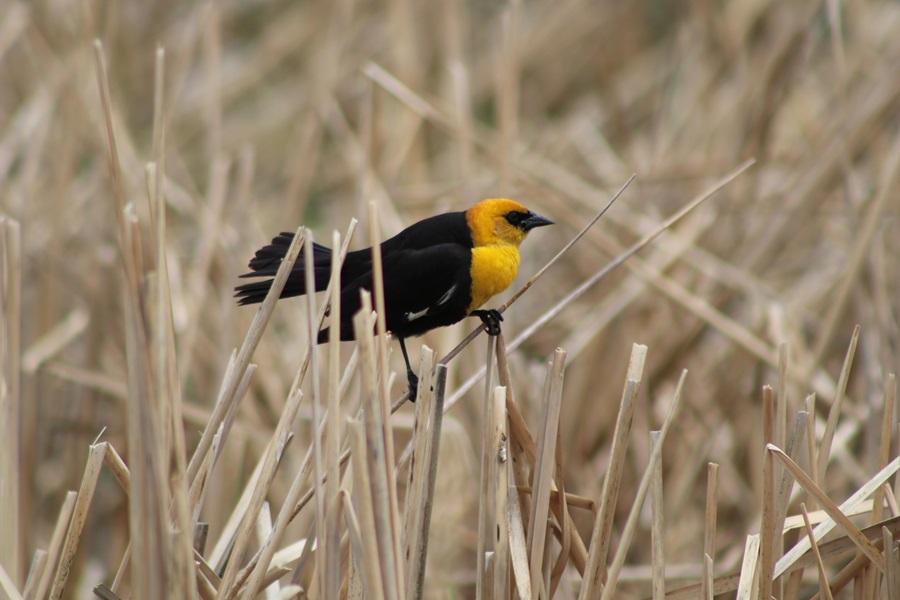Late fall is a good time to find rarities on Cape Cod. A few far-flung birds can be counted on to arrive from the Great Plains, the Rocky Mountains, and the southwestern United States at this time of year, and birders will congregate to see them.
One of the biggest birding destinations on the Outer Cape this fall has been Old North Cemetery next to Route 6 in Truro. Old North hasn’t been a particularly popular birding spot here — until now.
Birder Phil Brown was driving down Route 6 on Oct. 28, and as he passed the cemetery, he saw a flock of starlings and brown-headed cowbirds sitting on the wires. But among these black and brown birds he noticed one bird that looked different. He quickly pulled over to get a closer look at what turned out to be a yellow-headed blackbird.

Yellow-headed blackbirds typically live in the American West and are rare visitors to the Outer Cape. This species is sighted less than once each year here, and more often than not it is seen only once before vanishing. This particular bird, though, was no one-day wonder: The next morning it was back on the wires, and birders started showing up to see it.
One of them was Peter Grose. While waiting for the blackbird to show up shortly after sunrise, he spotted a strange sparrow associating with a small flock of chipping sparrows in the cemetery and quickly realized this bird was a lark sparrow — a large sparrow with a beautiful facial pattern that is also a rare visitor from western North America. Only one or two of these are seen each year on the Outer Cape. This bird, too, drew a small crowd of birders over the course of its stay in Truro.
Why would two rare Western birds be found on this one patch of land within 24 hours of each other? It’s natural to think there must be something special about the cemetery that birders were blind to, something only sparrows and blackbirds can see.
More likely, though, what happened here was an example of what bird-watchers call the Patagonia Picnic Table Effect.
The phenomenon takes its name from what happened at a rest stop along Arizona State Route 82 near the town of Patagonia. In the late 1960s and early 1970s, a series of rare birds were found there. As author Kenn Kaufmann writes in his book The Kingbird Highway, a local birder discovered that this unassuming rest stop was a reliable spot for rare Mexican species like rose-collared becard and thick-billed kingbirds. His observations naturally drew more birders to the site.
Once birders were on the scene regularly, they saw more rarities. Some of these, like a yellow grosbeak and a flock of black-capped gnatcatchers, were so rare that they had never been seen in the U.S. before at all. Thus, the Patagonia Picnic Table Effect: rare birds attract birders, who, simply by being there, turn up more rare birds.
Old North Cemetery is not the only place this has happened on the Cape. When Massachusetts’s first Siberian sand-plover was found in Mashpee this past summer, birders who went to look for it found a rare Baird’s sandpiper. In Bourne, in January 2021, birders looking for a black-headed gull (a vagrant from Europe) found an ash-throated flycatcher (a vagrant from the Southwest), then birders looking for that bird found a Townsend’s warbler (a vagrant from the Pacific West).
Seeing a variety of rare birds on the same day is delightful. And each time it happens, there’s a sort of unspoken question: had the initial bird not shown up, would the subsequent rarities have ever been found?
We’ll never know, of course, whether the lark sparrow at Old North Cemetery would have been found had Phil Brown not spotted the yellow-headed blackbird first, but it is easy to imagine it wouldn’t have been. Before Brown posted about his sighting, people were birding the cemetery about once a month at best, according to data from the website eBird. That leaves plenty of time for a rare sparrow to go unnoticed.
If the Patagonia Picnic Table Effect tells us anything, it is that there are a lot of rare birds that are missed unless birders have a reason to stumble upon them. I wonder if this fall’s sightings will bring more bird-watchers to Old North Cemetery for years to come. After all, the next rare bird could be there right now.



